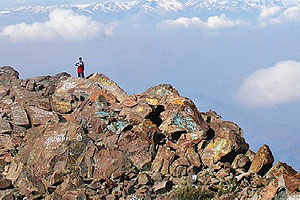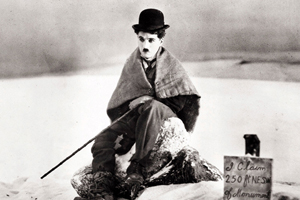The Chonchon
The legend goes that when the inhabitants of the central zone of the country heard the constant screams of the Chonchon (meaning “tue,tue”), it meant the bird was out to announce that someone was going to die.
This warlock took on the form of a bird with a human head, which sprouted huge ears that he used as wings to fly. He would settle into the room of the diseased and flap around, fighting against their spirit, and if he could, he would suck the blood of the patients.
It is said the chonchones knew a great deal about witchcraft, for they knew the secret to levitation. This way, they would apply certain creams on their throats, managing to fly only with their head, because they left their bodies at home. When they begun flight they would say: Without God or Holy Mary. In order to scare them off, people would recite the following prayer: «Saint Cipriano goes up, Saint Cipriano goes down, holding a candle for a rightful death». With these words, the Chonchon would fall to the ground. Another method for scaring them away was to pour salt on the kitchen fire and say: «Be on your way Chonchon or come back for salt tomorrow». The next day, if anybody showed up asking for salt, you could not refuse no matter what.
One could also draw the cross of Salomon (a five pointed star) on the ground and then stick a knife in the center with the point facing the Chonchon. When he passed by he would fall and become impaled on the blade. Then he had to be grabbed and burned.
In addition, it is said that other warlocks hunted the monster in order to create powerful spells they then used to many different ends.
The Calchona
It is said that a married couple lived blissfully in the countryside along with their two children. However, no one in the family knew the wife was a witch and in her house she hid several jars containing magical ointments, which, when applied to the body, transformed them into a black sheep.
At night, while everyone slept, she would perform the rite of putting on the creams and wandering the fields transformed into an animal. Upon her return the following morning, she would apply the ointments again and recover her form as a woman.
One day, her children saw her perform the spell and they wanted to imitate her, so they put on the creams, becoming little foxes. But when they wanted to become kids again, they couldn’t figure out how and started to cry.
At that moment, the father was awoken by the sobbing and he was greatly surprised, for, instead of encountering his children, he saw two animals. He quickly realized they were his kids and imagined it might be a spell, so he started to look for jars that might contain some kind of magical ointment. When he found the creams, he applied them immediately and they became children once again. The little ones told him their mother was the owner of the jars, and the father, quite frightened and in order to prevent this from happening again, threw them into the waters of a river.
The following morning, the mother, still in sheep form, returned home and began to search for her ointments. She only found nearly empty jars and, in despair, she tried to use the leftover creams to transform herself into a woman again. Yet, she only had enough for her hands, face and hair. The rest remained as a sheep.
Thus, it is said that when peasants hear sheep baa at night, they immediately know it is the Calchona (the name they gave this animal). As a tradition, everyone leaves a plate of food for her because she is said to be totally harmless and regrets her old acts of witchcraft.
The cave of the chivato
It is said this cave existed at the foot of Concepcion hill, in Valparaiso. In it, there lived a monstrous goat that would go out at night and catch anybody that passed outside the place.
It had a piercing stare that could hypnotize its victims, preventing any attempt to flee. The few who managed to get away would do so with such despair that they died along the way or they escaped and left their personal belongings behind. The ones caught by the chivato were taken inside the cave and turned into imbunches. However, the person who did not want this transformation had to go through the challenge of undoing the curse suffered by a woman the chivato kept in the most hidden corners of his dwelling.
Those that risked breaking the spell had to first fight a snake that would slither up their legs and wrap itself around their waist, arms and throat or kiss them on the mouth.
Then, they had to fight to get through a group of rams, which used all of their might to grab anyone who attempted to pass. If the men managed to pass this test, they then had to cross a path filled with crows that tried to peck their eyes out and soldiers that stabbed them with their swords.
But, since none of them completed the task, they were left with no choice but to keep their lives and let the goat turn them into imbunches and live as subjects of this monster forever. In addition, nobody returned from the cave to say what was going on, so there was hardly a family that didn’t mourn the loss of a relative, nor a mother that did not cry over a son that had been stolen and turned into an imbunche. (Version based on Oreste Plath’s compilation).
The Cristo de la Matriz (Christ of the Womb)
In 1630, king Phillip II of Spain donated the Cristo de la Agonia (Christ of Agony) to the cathedral of Santiago. This piece was given as compensation for the profanation of the old La Matriz chapel, located at the foot of Santo Domingo hill (Valparaiso), which was the work of English pirate Francis Drake.
The Cristo de la Agonia was a wood-carved crucifix made by a Japanese sculptor and it arrived to Valparaiso in a great crate, remaining at the port for a long time. When attempts were made to transport it to Santiago, which was supposedly its final destination, the yoke of oxen that pulled the wagon carrying the crate stopped in front of La Matriz chapel and didn’t budge. This, because the crate was too heavy, and on top of that, it was winter and there was a torrential downpour, sinking the wagon wheels in the mud.
New yokes were added, but it was all to no avail, for the wagon remained stuck.
The, it was decided to lower the crate and leave it at the chapel. As soon as it was unloaded, the wagon was free of the mud, so the loaders placed it back on, but when it was on the wagon again, the wheels got stuck in the mud again.
A few locals who observed the scene suggested they open the package and make sure of what was inside. When it was opened and the image of the Cristo de la Agonia appeared, the rain and strong wind that had prevented its transportation stopped immediately.
Many faithful believed this event was nothing short of a true miracle, so the crucifix was left in this chapel for good, for it was the expressed wish of God.
From that moment on, the sacred image is worshipped and many people are sure that, year after year, the Christ bows his head more and more, which will cause it to one day break off completely, and this will mark the end of the world. (Version based on Oreste Plath’s compilation).
The Lagoon of the Inca
This lagoon is found amidst the Andes mountains (where the Portillo ski center is located nowadays) and for many it represents a sad love story.
The story goes that before the arrival of the Spanish, the Incas had achieved domination all the way to the banks of the Maule river, and their religious rituals and ceremonies were held in the Andean zone.
At the lagoon, Incan Yupanqui married the beautiful princess Kora-lle, and when the ceremony was over, she had to comply with the last rite: go down the slope of the hill with her great gown and jewels, followed by her servants.
The road was narrow, slippery and lined by deep precipices. The princess was coming down when she fell to the depths. Upon hearing the screams, Illi Yupanqui ran to her aid, but when he got there, she was already dead. At that moment, he decided that his wife was to be deposited at the depths of the lagoon, and as he had cried inconsolably, the waters of the lagoon turned an emerald color.
It is said that from that day forth the lagoon has been enchanted, and on certain winter nights, the soul of the Incan wanders the area voicing sorrowful laments.
The spell of la Campana Hill and the Roca del Buey (Stone of the Ox).
Stories are told that say a few centuries ago, at the top of La Campana hill (province of Quillota), there was a rock filled with gold and other precious stones. It was sought after by a foreign nation, which sent a group of men to take the gold.
However, the warlocks of this place heard of the plan and decided to mock the greed of the outsiders, dropping a thick shower of granite (a rock made of feldspar, quartz and mica) on the hill that night, which hid the beautiful riches.
Years have gone by and many people continue to search for the treasure on this hill. But the warlocks keep sharp knives that they will use to take the life of whoever breaks the stone’s spell. (Version based on Oreste Plath’s compilation).
On the other hand, in the bay of Valparaiso, there is the stone of the ox, a dangerous rock that floats on the surface. It is said numerous accidents have taken place at this spot, including a corvette carrying a group of professors and students from France and Belgium. This made it necessary to place a buoy there, which came to be known as the ox buoy due to the resemblance it had with the noise this animal makes when there are high swells. It was useful for ships because it announced that danger was nearby. (Version based on Oreste Plath’s compilation).
The roadside shrine of Juanita Ibañez
In Linares, Juan Ibañez Valenzuela had a butcher shop on 1435 Delicias street. At this same stop, he lived with his daughters Juana and Gladys Rosa. The former was a fifteen year old student at the Liceo de Niñas (School for Girls) and the later was a ten year old third grader at Escuela Nº3 (School Nº3).
One day, their father got sick and had to be taken to Santiago to be hospitalized. The girls were left in the care of the housekeep, Mercedes Gajardo, who was only 17 years old.
She knew there was money in Juan Ibañez’s nightstand and decided to steal it at night. Armed with a hammer, she headed towards the room where the girls were sleeping and hit them on the skull. The eldest died and the other was left gravely injured.
She then tried to open the nightstand, but since she couldn’t, she decided to take the piece of furniture to the house of sisters Maria and Emiliana Estrada, who became her accomplices. At that place, they broke open the nightstand and took the money and later made a quick escape.
A deaf brother of Juan Ibañez who lived in the house sensed something serious had happened, so he set off to look for the carabineros (police) and the town mayor, who lived across the street. A few days later, they managed to arrest the women at the train station of the city of Curico.
After Juana’s body was taken to the cathedral, there was an endless procession of students from her school and of hundreds of people who wanted to offer her one final tribute. The impact of the girl’s death lingered for a long time, so it was decided to erect a popular altar, the roadside shrine of Juanita Ibañez.
It is said that when her devotees, mainly students, ask her to do well on their exams, she always makes their wish come true. (Version based on Oreste Plath’s compilation).








 Nace Charles Chaplin
Nace Charles Chaplin